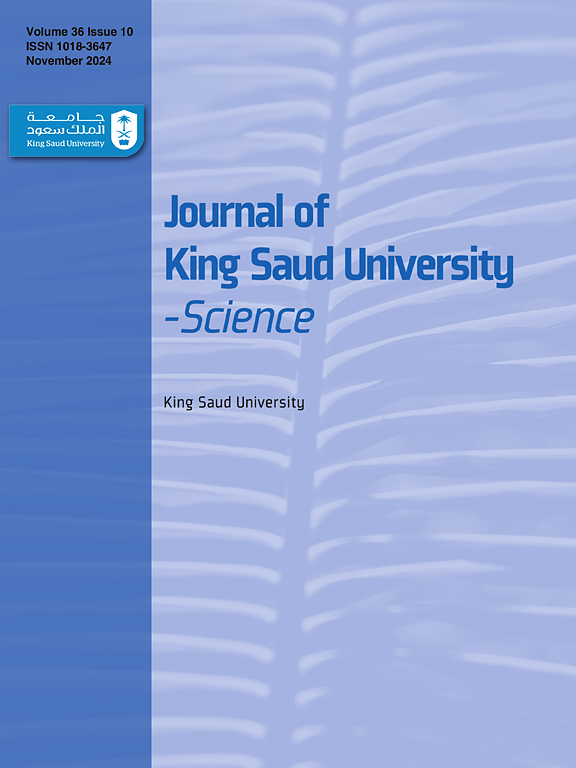Analysis of structural architecture in western Saudi Neom City area, northwestern Arabian Plate: Field investigation
IF 3.6
3区 综合性期刊
Q1 MULTIDISCIPLINARY SCIENCES
引用次数: 0
Abstract
Saudi Neom City is being constructed as an urban mega-project in the northwestern part of the Arabian plate at the southeastern part of the NNE-oriented sinistral Dead Sea continental transform fault that links the NNW-oriented Red Sea Rift to the Zagros collision through the NE-oriented sinistral East Anatolian Fault. The present study aims to detect and analyze the different structural elements in the western Neom city. It also attempts to provide valuable data to help decision-makers for better achievement of such vital projects. From field investigation, the study area mainly comprises Neogene sedimentary sequence and exhibits a complex structural architecture represented by extensional- and wrench-style deformations. Different fault orientations (NNW–SSE striking extensional faults, WNW–ESE and ENE–WSW striking oblique-slip faults, and NNE–SSW and NNW–SSE striking strike-slip faults) dissect the western Neom area. Individual NNW-oriented Red Sea Rift-related extensional faults and fault blocks are antithetically tilted to the northeast. The sinistral movement onset along the Dead Sea Transform Fault postdates the Lower Miocene Burqan Formation deposition. Furthermore, the sinistral strike-slip regime of the western Neom area involves extensional structures, including normal faults, contractional structures (folds and reverse faults), and structures representing horizontal shear on near-vertical planes. NNW-oriented negative flower structures and forced folding occur along a synthetic NNW-oriented sinistral strike-slip fault set. Contractional structures are expressed by sets of NE-oriented left-handed en echelon-arranged folds in the Middle Miocene deposits. A proposed strain ellipse reveals these structures are associated with the NNE-oriented sinistral Dead Sea Transform Fault. The complexity of the structural architecture of the western Neom area can be attributed to its geologic setting under the influence of the Red Sea extensional rifting followed by the tectonic activity along the Dead Sea transform faulting. It is recommended that the structural attributes investigated, especially the geographic distribution of brittle structures (faults and fractures), be considered during the construction of Neom City.
阿拉伯板块西北部沙特内奥姆城西部地区的结构建筑分析:实地考察
沙特内奥姆城是阿拉伯板块西北部的一个特大城市项目,位于 NNE 向正弦死海大陆转换断层的东南部,该断层通过 NE 向正弦东安纳托利亚断层将 NNW 向红海裂谷与扎格罗斯碰撞联系起来。本研究旨在探测和分析 Neom 市西部的不同结构要素。本研究还试图提供有价值的数据,帮助决策者更好地完成此类重要项目。通过实地考察,研究区域主要由新近纪沉积层序组成,并呈现出以伸展型和扳动型变形为代表的复杂构造结构。不同的断层走向(NNW-SSE 向伸展断层、WNW-ESE 向和 ENE-WSW 向斜滑动断层、NNE-SSW 向和 NNW-SSE 向冲击滑动断层)将 Neom 西部地区分割开来。与红海断裂相关的各个 NNW 向伸展断层和断层块向东北方向反向倾斜。沿死海转换断层的正弦运动开始于下中新世布尔干地层沉积之后。此外,尼翁西部地区的正弦走向滑动机制涉及延伸构造,包括正断层、收缩构造(褶皱和逆断层)以及近垂直面上代表水平剪切的构造。NNW向负花构造和强迫褶皱沿合成的NNW向正弦走向滑动断层组出现。在中新世沉积层中,收缩构造表现为一组东北向左旋梯状排列的褶皱。一个拟议的应变椭圆显示,这些结构与 NNE 向的正弦型死海转换断层有关。Neom 西部地区结构构造的复杂性可归因于其地质环境受红海伸展断裂的影响,以及沿死海转换断层的构造活动。建议在 Neom 市建设过程中考虑所调查的结构属性,特别是脆性结构(断层和断裂)的地理分布。
本文章由计算机程序翻译,如有差异,请以英文原文为准。
求助全文
约1分钟内获得全文
求助全文
来源期刊

Journal of King Saud University - Science
Multidisciplinary-Multidisciplinary
CiteScore
7.20
自引率
2.60%
发文量
642
审稿时长
49 days
期刊介绍:
Journal of King Saud University – Science is an official refereed publication of King Saud University and the publishing services is provided by Elsevier. It publishes peer-reviewed research articles in the fields of physics, astronomy, mathematics, statistics, chemistry, biochemistry, earth sciences, life and environmental sciences on the basis of scientific originality and interdisciplinary interest. It is devoted primarily to research papers but short communications, reviews and book reviews are also included. The editorial board and associated editors, composed of prominent scientists from around the world, are representative of the disciplines covered by the journal.
 求助内容:
求助内容: 应助结果提醒方式:
应助结果提醒方式:


